|
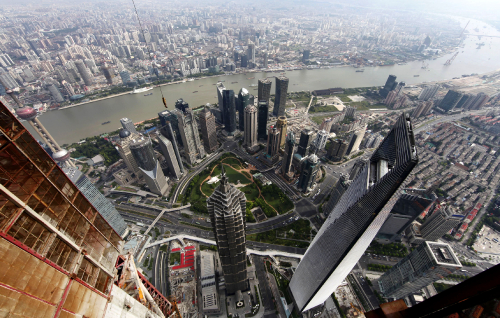 |
|
A bird's-eye view of the Pudong New Area of Shanghai (XINHUA) |
"It is a magnificent city that can make any dream come true!" Tim Cook, CEO of Apple Inc., commented while visiting Shanghai on May 14.
After making efforts for more than a decade to construct the city into an international center of economy, finance, trade and shipping, Shanghai now is making steps toward becoming a center of science and technology.
On May 25, Shanghai announced that by 2020, it will have formed the basic structure for science and technology innovation. It will then spend another 10 years completing core functions as a hi-tech innovation center. Following this, a series of policies has been released in early July.
Shanghai made this plan based on one-year of solid research led by the top municipal leadership. Building Shanghai into a science and technology innovation center with global influence has been listed as the top task for Shanghai in 2015.
Since 2000, the economy in Shanghai has been slowing down, especially after the global financial crisis in 2008, which forced the world to seek another development path. The GDP in Shanghai in 2008 only increased by 9.7 percent, and in 2014, it dropped further to 7 percent.
"Scientific and technological innovation will be the main engine for Shanghai's future development," said Han Zheng, Secretary of the Shanghai Municipal Committee of the Communist Party of China.
During an inspection to Shanghai in May 2014, President Xi Jinping said that scientific and technological innovation has become a key support for enhancing the overall power of a country. Whoever can grab this opportunity will win a crucial advantage. Xi encouraged Shanghai to become the leading city in China in this field and become a new innovation center with global influence.
Some experts explained this new title in three parts. "Global influence" means it needs to figure out and follow the global technological innovation trend and gather innovative resources on a global scale. "Scientific and technological innovation" means to closely keep up with the most advanced technology in the world, and "center" means to play a leading role and influence the surrounding area.
Now, some cities in the world, including New York City, London, Tokyo and Seoul, all made similar plans for scientific and technological innovation. Li Wan, a researcher at Shanghai Institute for Science of Science, said that in the following 10 to 20 years, there will be a new technological and industrial revolution, and China will definitely not be excluded. "Shanghai, as an international metropolis, needs to follow," said Li.
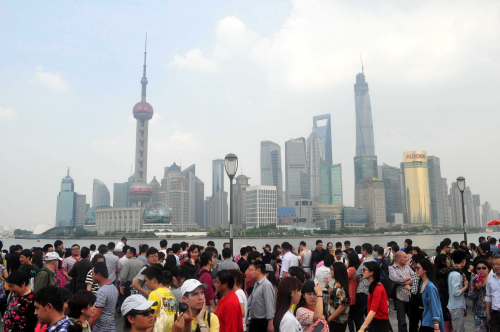 |
|
The Bund of Shanghai is a popular tourist destination (XINHUA) |
Settled in Shanghai
Some people, though, are not optimistic on Shanghai's development with this new title. Compared with Beijing and Shenzhen in south China's Guangdong Province that have a more vibrant atmosphere and gather more talents in the field of hi-tech innovation, Shanghai seems to have few advantages and has even displayed a declining trend in recent years.
Shanghai still lacks big companies like Baidu, Alibaba and Tencent, known together as BAT. For some local famous companies like the travel service company Ctrip, hotel chain company Rujia and online game developer Shengda Games, the total market value of the three combined can't be compared to any one of the BAT.
One reason, some experts claimed, for Shanghai having no giant private companies, might lie in the local culture, which is more conservative and pragmatic and isn't likely to believe in big dreams that giant companies put forward as slogans.
"The local entrepreneurs always choose industries that are closely connected with daily life, like hotels or restaurants," said an anonymous entrepreneur in Shanghai. Compared to this, Baidu's tagline "provide information fast and convenient" seems to be less relative to daily life.
"But if you understand more about the core of scientific and technological innovation, you will find out that Shanghai is the very right place to shoulder this responsibility," said Shangguan Ping, a commentator for the local newspaper Jiefang Daily. "It doesn't have as many R&D institutions as Beijing or Shenzhen, and the total economic volume is not as much as that of Jiangsu and Zhejiang provinces, but if you combine all the elements involved and evaluate them comprehensively, there are few places in China that can compete with Shanghai."
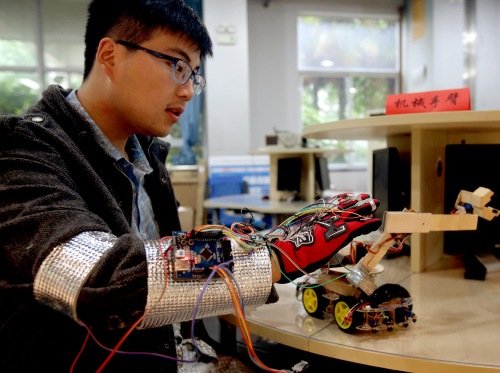 |
|
A college student from Shanghai Second Polytechnic University displays a self-developed robot on June 2 (XINHUA) |
Like the Zhongguancun Hi-Tech Area of Beijing, Shanghai's Zhangjiang Hi-Tech Park is also well-known. Established in July 1992, the park is one of China's first state-level hi-tech zones approved by the State Council as well as the core park of the Zhangjiang National Innovation Demonstration Zone. The establishment has attracted a large number of top hi-tech enterprises and small-to-medium-sized innovative enterprises. It is also perfectly poised to be the birthplace of new technology in east China.
The location of Shanghai is irreplaceable. It serves both as a window to the outside world and a developed center that can radiate to many places in China. With several leading universities including Fudan University, Shanghai Jiaotong University and about 209,000 R&D personnel, the input that Shanghai has made on R&D has been increasing largely in recent years, ranking only after Tokyo and Silicon Valley among 1,000 cities around the world.
Shanghai's industrial structure and corporate constitution are also quite comprehensive. A number of the time-honored state-owned enterprises are located in Shanghai, many of which already have a strong international edge. Besides, many more foreign-funded enterprises and foreign-funded R&D institutions are also based in the city. Some large private companies, including Minsheng Insurance and Wanda Group, moved or plan to move their headquarters to Shanghai. The newly opened free trade zone also provides a strong support.
"Being a scientific and technological innovation center demands the overall power of a city," said Shangguan. "Shanghai, with rich resources and talents in science and technology as well as comprehensive infrastructure and sound legal environment, will be qualified."
Actually, the city of Shanghai has grown with a series of open policies. Openness is Shanghai's biggest advantage. With the reform and opening-up policy carried out in 1978, Shanghai made remarkable changes. As of December 2014, foreign investors had set up 484 headquarters in Shanghai. "For current Shanghai, 'being open' is not only limited to open economy. It is involved in every aspect of the city, and this has made Shanghai an ideal place for gathering the global innovation resources," said Shangguan.
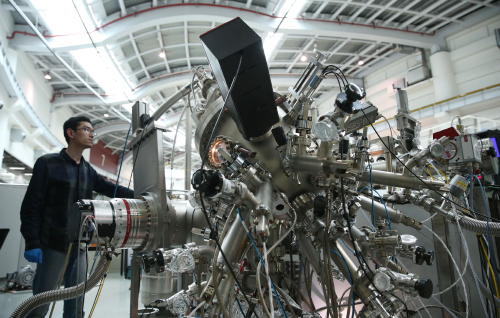 |
|
A technician from the Chinese Academy of Sciences Shanghai Branch performs an experiment in a lab on May 27 (XINHUA) |
Meanwhile, the Shanghai Municipal Government believes that the reform of institutional mechanisms will also be an important safeguard for the city drive toward becoming a hi-tech and innovation center. "At present, the R&D chain is not running smoothly from lab to market due to irrational institutional mechanisms," said Han. Shanghai will be in full swing to remove the institutional barriers and stimulate innovation and creativity.
In 1988, the metropolitan city set up the Shanghai Technology Innovation Center (STIC), a non-profit public institution. The STIC incubation base, as a technology incubator, is invested in by the Shanghai government and directed by the STIC with the authorization from the Science and Technology Commission of the municipal government.
With the aim to "transfer technology achievements, incubate technology enterprises and cultivate technology entrepreneurs," the STIC strives to build an excellent innovation environment to provide comprehensive services to technology enterprises and innovators for the commercialization, industrialization and internationalization of hi-tech technology achievements.
As the parent organization of the Shanghai Technology Business Incubation Association, the STIC takes extensive advantage of social resources and policies. A dozen technology business incubators, including the Yangpu and IC Design incubator, were invested in and established directly by the STIC, which form an incubation service system covering the entirety of Shanghai and improve Shanghai technology business incubators' specialization, standardization and internationalization.
Headed by the STIC, Shanghai International Business Incubator (IBI) takes the organization model of One Incubator, Several Bases. The Incubator has six incubation bases with international business incubation qualifications, including the STIC, Caohejing, Zhangjiang, Yangpu, Withub and Shanghai University S&T Park. IBI devotes its time to extensive communication and cooperation with well-known international incubators and has established close cooperative relationship with incubators and counterparts in foreign countries such as France, Japan, Russia, the United States, South Korea and the UK.
New visa policy
Shanghai has implemented a new visa policy for foreigners, especially hi-tech talents working in Shanghai since July 1. The new regulations cover the criteria for high-level foreign workers, easier ways for issuing their visas and a lower threshold to apply for permanent residency in China. It is the first time that high-level foreign workers are to be identified by their income and tax payments rather than job titles.
According to the original regulations, if foreigners want to work in China, they must be employed first or obtain a specialist permit, then exit and come back with work visas issued by the Chinese embassies. Only after all this can they apply for residence permit. The new rules state that abroad foreigners with a work permit can apply for a work visa. Foreigners living in Shanghai with a work permit can apply for a one-year residence permit from the Exit-Entry Administration of Public Security and then proceed the employment procedures.
Visas on arrival will be issued to high-level foreign workers and those bringing entrepreneurial skills to the city. Foreigners with either an invitation from a licensed hi-tech enterprise, a talent certificate awarded by the Shanghai human resources authority or an endorsement from a hi-tech business incubator will no longer need to leave the country to obtain a work visa.
Those with an annual income of 600,000 yuan ($96,700) or above and who have paid 120,000 yuan ($19,672) as individual income tax per year for four consecutive years are able to apply for a permanent residence permit. Under the original provisions, though, only foreigners working at or above the level of vice-general managers or holding professional titles at or above associate researchers qualified to apply.
Moreover, the amount of time these foreigners need to have lived in China to apply for permanent residence has been eased. Compared to the original provision, which required a duration of no shorter than three years within a four-year work experience, the new policy requires a period of no less than six months each year.
The highlight in the new policy is more compact and transparent channels for foreigners to apply for visas and residence permits so that more talent from around the world can be attracted and retained.
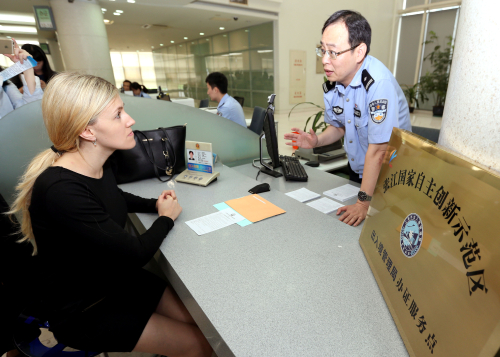 |
|
A French citizen consults for new visa rules in the Exit-Entry Administration of the public security authorities in Shanghai on July 1 (XINHUA) |
"Shanghai needs hi-tech talent to transform its growth mode and maintain rapid economic development," said Sun Yongqiang, Vice Chairman of Shanghai Pudong New Area Business Council. "On the other hand, these breakthroughs will help render a promising future for international technology innovators in the city."
If you work for the company which has the valid hi-tech certificate, you can apply for the talent residence permit (R visa) for five years. After you continuously work for the company over three years, then you can apply for the permanent residence permit (China green card).
A foreign student who has just graduated from a university in China can apply for a two-year personal affairs residence permit (S1 visa) to allow for time for an established business if they plan to invest in or open their own business in Shanghai.
The new rules also state that foreign employees can apply for Z visas without leaving the country, and after two years of continuous work in Shanghai with a working visa, they can apply for five-year long-term working residence permits.
Copyedited by Kylee McIntyre
Comments to tangyuankai@bjreview.com
| 